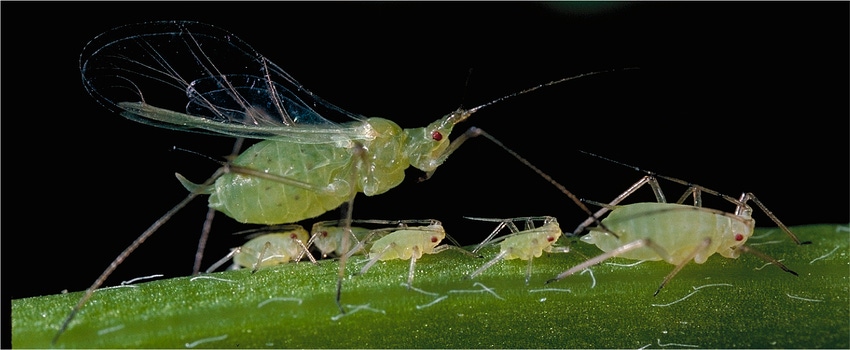
Aphid identification in desert-grown alfalfa
In Arizona alfalfa, the pea aphid, blue alfalfa aphid, spotted alfalfa aphid, and cowpea aphid make up the winter-time aphid complex.All species cause similar damage, but spotted alfalfa aphid and blue alfalfa aphids are the most damaging in the system.Pea aphids feed on the entire plant while blue alfalfa aphids feed mainly on terminal leaves and young shoots.
March 25, 2013

By Lydia Brown, Ayman Mostafa, Al Fournier, and Peter Ellsworth, University of Arizona
In Arizona alfalfa, the pea aphid (Acyrthosiphon pisum), blue alfalfa aphid (Acyrthosiphon kondoi), spotted alfalfa aphid (Therioaphis maculata), and cowpea aphid (Aphis craccivora) make up the winter-time aphid complex.
All species cause similar damage, but spotted alfalfa aphid and blue alfalfa aphids are the most damaging in the system.
Pea aphids and blue alfalfa aphids are about one-eighth-inch long with greenish bodies. These aphids can be distinguished by their antennae and feeding behavior.
Pea aphids have dark narrow bands at the tip of each antennal segment. Blue alfalfa aphids have dark brown antennae which gradually darken from the base to the tip.
Pea aphids feed on the entire plant while blue alfalfa aphids feed mainly on terminal leaves and young shoots.
The spotted alfalfa aphid is one-eighth-inch long and is yellowish gray in color with several rows of tiny black spots on the back. It prefers to feed on the undersides of leaves and lower sections of the plant.
The cowpea aphid is the only black aphid found in alfalfa.
Want access to the very latest in agriculture news each day? Sign up for the Western Farm Press Daily e-mail newsletter.
Adult aphids may be winged or wingless. Immatures are always wingless and smaller. It is more difficult to distinguish immatures based on the characters above so look for adults in the colony to identify the species.
Aphids damage crops by siphoning phloem (sap) from plants. Yellowing and leaf curling are the most common damage.
Spotted alfalfa aphid and cowpea aphid inject toxins during feeding. This results in stunted plants with short internodes and yellow, deformed leaves. Heavy aphid infestations can cause plant death in susceptible varieties.
Aphids produce sugary honeydew which promotes growth of sooty molds. Sooty molds reduce plant vigor by blocking photosynthesis and decrease palatability to livestock.
Aphids produce live young (not from eggs) and can reproduce sexually or asexually. Asexual reproduction results in all female offspring.
Aphids have telescoping generations, which means that the young, even when inside the mother, may have young of their own developing within. Due to this, aphid populations can skyrocket over short periods of time making biweekly sampling important.
To view this IPM short on line, including photos, click on this link: http://ag.arizona.edu/crops/cotton/files/AlfalfaAphidDiagnostics.pdf.
More Western Farm Press News:
You May Also Like



